Side Menu:
Second Officer C.H.Lightoller
- Sinking and Collapsible B
2:15am Collapsible B
Technically, lifeboat collapsible D is the 'last boat' that Second Officer Lightoller launched as collapsible B was never successfully loaded and launched, but instead floated off upside down and ultimately became a refuge for Lightoller and 30 others after the sinking.
At the British Inquiry he describes how they started work on B:
"I called for men to go up on the deck of the quarters for the collapsible boat up there. The afterend of the boat was underneath the funnel guy. I told them to swing the afterend up. There was no time to open her up and cut the lashings adrift. Hemming was the man with me there, and they then swung her round over the edge of the coamings to the upper deck, and then let her down on to the boat deck. That is the last I saw of her for a little while…. the water was then on the boat deck." (British Inquiry(24.))
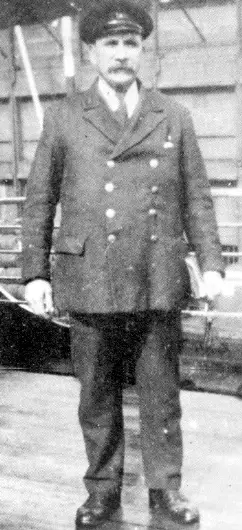
Lamp Trimmer Samuel Hemming
In his book he describes how he was assisted by lamp trimmer Samuel Hemming:
”With one other seaman I started to cast adrift the one remaining Engleheart on top of the officer’s quarters. We cut and threw off the lashings, jumped round to the inboard side ready to pick up the gunwale together and throw her bodily down on the boat deck….We had just time to tip the boat over, and let her drop into the water that was now above the boat deck, in the hope that some few might be able to scramble on to her as she floated off.”(47.)
Thus collapsible B was actually upside down on the boat deck shortly before the boat deck went under the rising water.
With little else to be done now that collapsible B had floated off, Lightoller and Hemming explored options on the starboard side:
”Hemming and I then, as every single boat was now away from the port side, went over to the starboard side, to see if there was anything further to be done there. But all the boats on this side had also been got away, through there were still crowds of people on the deck.” (47.)
At the British Inquiry he added further details, saying that he saw First officer Murdoch: "And coming over to the starboard side on the roof of the officers’ quarters, could you see any other officers? - I saw the First Officer working at the falls of the starboard emergency boat, obviously with the intention of overhauling them and hooking on to the collapsible boat on their side….There were a number round there helping." (British Inquiry(24.))
Later, in a letter dated April 24th, 1912 and written in the Hotel Continental, Washington, and co-signed by Officers Boxhall, Pitman and Lowe, Lightoller and addressed to First Officer Murdoch's wife Ada, he explains his final moments:
I was practically the last man, and certainly the last officer, to see Mr. Murdoch. He was then endeavouring to launch the starboard forward collapsible boat. I had already got mine from off the top of our quarters. You will understand when I say that I was working the port side of the ship, and Mr. Murdoch was principally engaged on the starboard side of the ship, filling and launching the boats. Having got my boat down off the top of the house, and there being no time to open it, I left it and ran across to the starboard side, still on top of the quarters. I was then practically looking down on your husband and his men. He was working hard, personally assisting, overhauling the forward boat's fall. At this moment the ship dived, and we were all in the water. Other reports as to the ending are absolutely false. Mr. Murdoch died like a man, doing his duty.
However, it has been questioned whether Lightoller really saw Murdoch. In his book and evidence given at the US and British Inquiries he only ever mentioned 'crowds of people on the deck'. Titanic historian Don Lynch writes: “Certainly Lightoller’s testimony [regarding Murdoch] can be discounted –he may well have been attempting to protect the reputation of a fellow White Star officer, as well as that of his employers.” (Illustrated History, p.195 (2.) )
In his book, Lightoller paints a dramatic picture of Titanic's sudden plunge:
”Just then the ship took a slight but definite plunge—probably a bulkhead went—and the sea came rolling up in a wave, over the steel-fronted bridge, along the deck below us, washing the people back in a dreadful, huddled mass. Those that didn’t disappear under the water right away, instinctively started to clamber up that part of the deck still out of water, and work their way towards the stern, which was rising steadily out of the water as the bow went down. A few of the more agile leapt up on top of the officers’ quarters where Hemming and I were at the moment. It was a sight that doesn’t bear dwelling on—to stand there above the wheelhouse, and on our quarters, watching the frantic struggles to climb up the sloping deck, utterly unable to even hold out a helping hand.”(47.)
This plunge is when Lightoller decided to dive into the sea, although he describes it at the British Inquiry as 'walking into the sea':
"She seemed to take a bit of a dive, and I just walked into the water… I was swimming out towards the head of the ship, the crow’s-nest. I could see the crow’s-nest. The water was intensely cold, and one’s natural instinct was to try to get out of the water. I do not know whether I swam to the foremast with that idea, but of course I soon realised it was rather foolish, so I turned to swim across clear of the ship to starboard. The next thing I knew I was up against that blower on the fore part of the funnel. There is a grating…the water rushing down held me there a little while. The water was rushing down this blower… It held me against the blower….After a while there seemed to be a rush of air from down below, and I was blown away from it… I found myself alongside of the collapsible boat, which I had previously launched on the port side, the one I had thrown on to the boat deck.…I just held on to something, a piece of rope or something, and was there for a little while, and then the forward funnel fell down. It fell within 3 or 4 inches of the boat. It lifted the boat bodily and threw her about 20 feet clear of the ship as near as I could judge."(24.)
In his book written years later he describes his departure in more dramatic detail:
”I knew, only too well, the utter futility of following that driving instinct of self-preservation and struggling up towards the stern. It would only be postponing the plunge, and prolonging the agony—even lessening one’s already slim chances by becoming one of a crowd. It came home to me very clearly how fatal it would be to get amongst those hundreds and hundreds of people who would shortly be struggling for their lives in that deadly cold water. There was only one thing to do, and I might just as well do it and get it over, so, turning to the fore part of the bridge, I took a header. Striking the water was like a thousand knives being driven into one’s body, and for a few moments I completely lost grip of myself and no wonder, for I was perspiring freely, whilst the temperature of the water was 28º or 4º below freezing. Ahead of me the look-out cage on the foremast was visible just above the water—in normal times it would be a hundred feet above. I struck out blindly for this, but only for a short while, till I got hold of myself again and realised the futility of seeking safety on anything connected with the ship. I then turned to starboard, away from the ship altogether.”(47.)
Also according to his book, after struggling to stay above the surface, he realized that the weight of the Webley revolver was actually pulling him down. He wrenched the gun out of his pocket and let it sink into the ocean. Then he was drawn and held again the grating:
On the boat deck, above our quarters, on the fore part of the forward funnel, was a huge rectangular air shaft and ventilator, with an opening about twenty by fifteen feet. On this opening was a light wire grating to prevent rubbish being drawn down, or anything else being thrown down. This shaft led direct to No. 3 stokehold, and was therefore a sheer drop of close on hundred feet, right to the bottom of the ship.
I suddenly found myself drawn, by the sudden rush of the surface water now pouring down this shaft, and held flat and firmly up against this wire netting, with the additional full and clear knowledge of what would happen if this light wire carried away. The pressure of the water just glued me there whilst the ship sank slowly below the surface.
Although I struggled and kicked for all I was worth, it was impossible to get away, for as fast as I pushed myself off I was irresistibly dragged back, every instant expecting the wire to go, and to find myself shot down into the bowels of the ship.
Apart from that, I was drowning, and a matter of another couple of minutes would have seen me through. I was still struggling and fighting when suddenly a terrific blast of hot air came up the shaft, and blew me right away from the air shaft and up to the surface.
The water was now swirling round, and the ship sinking rapidly, when once again I was caught and sucked down by an inrush of water, this time adhering to one of the fiddley gratings. Just how I got clear of that, I don’t know, as I was rather losing interest in things, but I eventually came to the surface once again, this time alongside that last Engleheart (sic) boat which Hemming and I had launched from on top of the officers’ quarters on the opposite side—for I was now on the starboard side, near the forward funnel.”(47.)
Lightoller then goes on to describe the no.1 funnel falling on people in the water:
"There were many around in the water by this time, some swimming, others (mostly men, thank God), definitely drowning—an utter nightmare of both sight and sound. In the circumstances, I made no effort to get on top of the upturned boat, but, for some reason, was content to remain floating alongside, just hanging on to a small piece of rope.
The bow of the ship was now rapidly going down and the stern rising higher and higher out of the water, piling the people into helpless heaps around the steep decks, and by the score into the icy water. Had the boats been around many might have been saved, but, of them, at this time, there was no sign. Organised help, or even individual help, was quite impossible. All one could do was just wait on events, and try and forget the icy cold grip of the water. The terrific strain of bringing the after end of that huge hull clear out of the water, caused the expansion joint abaft No. 1 funnel to open up. (These expansion joints were found necessary in big ships to allow the ship to “work” in a seaway.) The fact that the two wire stays to this funnel, on the after part led over and abaft the expansion joint, threw on them an extraordinary strain, eventually carrying away the port wire guy, to be followed almost immediately by the starboard one. Instantly the port one parted, the funnel started to fall, but the fact that the starboard one held a moment or two longer, gave this huge structure a pull over to that side of the ship, causing it to fall, with its scores of tons, right amongst the struggling mass of humanity already in the water. It struck the water between the Engleheart (sic) and the ship, actually missing me by inches.
Amongst the many historic and, what in less tragic circumstances, would have been humorous—questions, asked by Senator Smith at the Washington Enquiry was “Did it hurt anyone?”
One effect of the funnel crashing down on the sea, was to pick up the Engleheart in the wash so created, and fling it well clear of the sinking ship.
When I again recognised by surroundings, we were full fifty yards clear of the ship. The piece of rope was still in my hand, with old friend Engleheart (sic) upturned and attached to the other end, with several men by now standing on it. I also scrambled up, after spending longer than I like to remember in that icy water.”(47.)
At the British Inquiry Lightoller was adamant that there was no split:
"The ship did not and could not have broken in two. …..I am rather under the impression that the whole of the third funnel was visible……After she reached an angle of 50 or 60 degrees, or something about that, there was this rumbling sound, which I attributed to the boilers leaving their beds and crushing down on or through the bulkheads. The ship at that time was becoming more perpendicular, until finally she attained the absolute perpendicular - somewhere about that position (describing), and then went slowly down. She went down very slowly until the end, and then, after she got so far (describing), the afterpart of the second cabin deck, she, of course, went down much quicker." (British Inquiry(24.))
In his book he also describes the final moments with the ship not splitting in two:
Lights on board the Titanic were still burning, and a wonderful spectacle she made, standing out black and massive against the starlit sky; myriads of lights still gleaming through the portholes, from that part of the decks still above water.
The fore part, and up to the second funnel was by that time completely submerged, and as we watched this terribly awe-inspiring sight, suddenly all lights went out and the huge bulk was left in black darkness, but clearly silhouetted against the bright sky. Then, the next moment, the massive boilers left their beds and went thundering down with a hollow rumbling roar, through the bulk-heads, carrying everything with them that stood in their way. This unparalleled tragedy that was being enacted before our very eyes, now rapidly approached its finale, as the huge ship slowly but sure reared herself on end and brought rudder and propellers clear of the water, till, at last, she assumed an absolute perpendicular position. In this amazing attitude she remained for the space of half a minute. Then with impressive majesty and ever increasing momentum, she silently took her last tragic dive to seek a final resting place in the unfathomable depths of the cold grey Atlantic.
Almost like a benediction, everyone round me on the upturned boat breathed the two words, “She’s gone.”(47.)
Lifebelt and faith
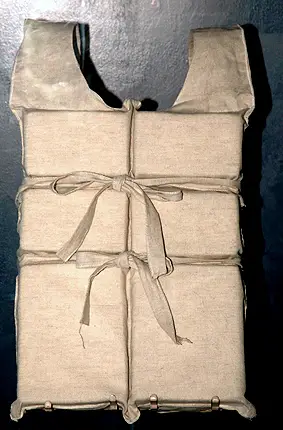
Titanic lifebelt, recovered from the
ocean in the area of the sinking.
At the British Inquiry Lightoller describes that wearing his lifebelt means you cannot swim but "you can paddle, they hold you high in the water."(24.) According to Ligtholler's article in the Christian Science Sentinel, Lightoller had only been wearing a lifebelt due to the fact that Chief officer Wilde had put on his lifebelt and as he passed his room (after getting a gun) he grabbed his own lifebelt too. In the article he attributes his survival to faith:
I want to emphasise strongly this point, that as soon as I collected my thoughts after taking to the water, I remember saying to myself, 'Now, I'll see how much I have learned from Christian Science.' A doubt never entered my mind as to the possibility of my surviving; in other words, of the ability of the divine power to save me. I think I can conscientiously say that with this thought all fear left me, and I commenced again to realise the truth of being. It was at this moment that I was drawn into the water, still realising the truth, and while I was below the surface these words from the 91st Psalm came to me so distinctly that I seemed to realise their full import: 'He shall give his angels charge over thee.' Immediately, I think, I was thrown away from the blower, and came up to find a piece of wood in my hand which seemed to be attached to the top of the funnel by a wire.
I remained still, while the water rushed past me carrying the people with it away from me. A second time I went down, still holding fast to the truth, and again came to the surface.
My piece of wood was gone, but alongside me was the flat-bottomed collapsible boat which I had thrown down on the other side of the ship. This I laid hold of, but made no attempt to board it.
I want it to be understood that during this time in the water the fact came calmly and clearly that there was a divine power which could be utilised in a practical manner, and also it seemed perfectly natural to rely on this power with the spiritual understanding which is so often spoke of in the Bible, and which is explained in 'Science and Health with Key to the Scriptures' by Mrs. Eddy.
Survival on an upside-down lifeboat
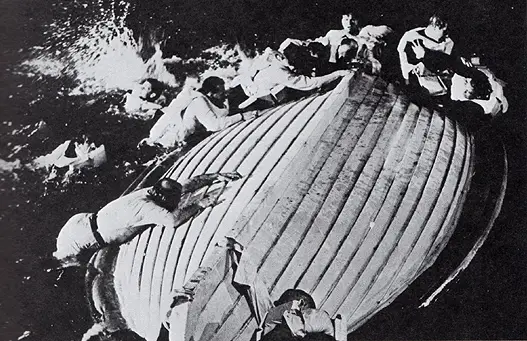
Survivors seeking refuge on the upturned collapsible B lifeboat, in a publicity image from the 1958 Rank film "A Night to Remember" (1958).
After the Titanic disappears beneath the sea, Second Officer Lightoller seeks refuge on collapsible B. He describes the scene in his book:
“Fortunately the scene that followed was shrouded in darkness. Less fortunately, the calm still silence carried every sound with startling distinctness. To enter into a description of those heart-rending, never-to-be-forgotten sounds would serve no useful purpose. I never allowed my thoughts to dwell on them, and there are some that would be alive and well to-day had they just determined to erase from their minds all memory of those ghastly moments, or at least until time had somewhat dimmed the memory of that awful tragedy.”
How anyone that had sought refuge on that upturned Engleheart [sic] survived the night is nothing short of miraculous. If ever human endurance was taxed to the limit, surely it was during those long hours of exposure in a temperature below freezing, standing motionless in our wet clothes. That the majority were still standing when the first faint streaks of dawn appeared is proof that whilst there is life there is still some hope.”(47.)
This was not made any easier by the sea conditions which Lightoller described at the British Inquiry: "After I was in the water I had not been on the raft, the upturned boat, more than half an hour or so before a slight swell was distinctly noticeable." (British Inquiry(24.))
The collapsible was slowly sinking so it became not only a balancing act but a race against time:
Hour by hour the compartments in this collapsible boat were surely filling with water, due, no doubt to the rough and ready treatment she had received when dumped incontinently from the top of our quarters, with a crash on to the boat deck, there to float off of her own sweet will.
The fact remains we were painfully conscious of that icy cold water, slowly but surely creeping up our legs.
Some quietly lost consciousness, subsided into the water, and slipped overboard, there being nothing on the smooth flat bottom of the boat to hold them. No one was in a condition to help, and the fact that a slight but distinct swell had started to roll up, rendered help from the still living an impossibility.
It was only by the grace of being huddled together that most of us didn’t add to the many that lost their lives that night.
Another thing, with the rising sea I realised that without concerted action , we were all going to be pitched headlong into the sea, and that would spell finish for everyone. So I made everyone face one way, and then, as I felt the boat under our feet lurch to the sea, one way or the other, I corrected it by the order “Lean to the right,” “Stand upright,” or “Lean to the left,” as the case may be.
In this way we managed to maintain our foothold on the slippery planks by now well under water.”(47.)
He described at the US Inquiry collapsible B as having about 30 people of which three or four died:
Mr. LIGHTOLLER: I think there were three or four who died during the night.
... I think the senior Marconi operator was on the boat and died. The Marconi junior operator told me that the senior was on this boat and died... I should roughly estimate about 30. She was packed standing from stem to stern at daylight...
Senator SMITH. There must have been a great number of people in the water?
Mr. LIGHTOLLER. But not near us. They were some distance away from us.
Senator SMITH. How far?
Mr. LIGHTOLLER. It seemed about a half a mile.
In regards to wireless operator Philips, Lightoller later wrote further about him:
“We knew that ships were racing to our rescue, though the chances of our keeping up our efforts of balancing until one came along seemed very, very remote. Phillips, the senior wireless operator, standing near me, told me the different ships that had answered our call. Of these, according to their positions, undoubtedly the Carpathia was nearest and should be up with the position where the Titanic sank, by daylight. For encouragement, I passed on to those around, my rough calculation and it certainly helped the struggle to keep up. As it turned out, the information from Phillips, and the calculation, were about right, though poor old Phillips did not live to benefit by it. He hung on till daylight came in and we sighted one of the lifeboats in the distance.”
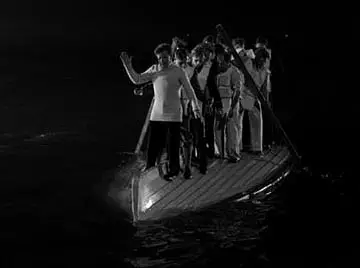
Kenneth More, as Lightoller, balancing the upturned
collapsible B in the 1958 film "A Night to Remember".
Allegedly, Lightoller allegedly refused a drink, according to his religiously framed article in the Christian Science Sentinel of October 1912 in which he wrote: "I could not overcome the intense cold experienced, yet when a man handed me a bottle of something that smelt somewhat like essence of peppermint, the thought of material means was nothing short of repulsive, and needless to say, it was not taken."
In his 1936 BBC broadcast Lightoller does mention praying:
Frankly, I don't think many of us expected to see daylight. At one time during the night, someone suggested we should say "Our Father" and I don't think it was exactly scare that made everyone join in. But you'd need to be in somewhat the same fix. Where a couple of minutes may mean all the difference between well here and Hereafter. to understand the feeling we put into it. I've heard that prayer ever since I was a child, but never with such intense earnestness, as the surroundings lent to it that night. However, when daylight did break most of us most of us were still heads up and we of the upturned boat transferred to one of the lifeboats. (BBC, 1936)
As daylight finally approached, Lightoller could see the area around him:
"Bergs... I should say the nearest must have been at least 10 miles away. That is a pretty rough estimate. I cannot say with any degree of accuracy now what the nearest was, it may have been less.… They ranged from a matter of 50 or 60 feet to perhaps 200 or 300 feet." (British Inquiry(24.))
Then Lightoller spotted another lifeboat, as described by Colonel Archibald Gracie during the US Inquiry:
"Then, as the sun came up, a welcome sight was the four lifeboats of the Titanic on our starboard side. Lightoller blew his whistle and ordered them to come over and take us off of our upset boat. "Aye, aye, sir," they replied, and immediately turned toward us, and two boats came right up close and then began the difficult task of a transfer, and some were loaded. We got on the nearest lifeboat, the bow of this, and some went on this one and some went on the one adjoining. The complement of the lifeboat I was on was filled up to 65."(25.)"
Lightoller himself described this at the British Inquiry:
There were nearly 28 or 30 people on this raft in the morning….. ... when I saw the boats I could faintly distinguish them. I had my whistle in my pocket. I whistled by way of showing it was an officer that was calling, and I asked them if they could take some of us on board, and I said if they could manage to take half-a-dozen - because we were sinking then - it would lighten us up so that we could continue afloat.(British Inquiry(24.))
In his book, he describes this in more detail:
We were beyond making her hear with our shouting, but I happened to have in my pocket the ordinary whistle which every officer of the Watch carries. This piercing sound carried, and likewise carried the information (for what it was worth) that it was an officer making the call.
Slowly—oh how slow it seemed—she worked her way towards us. Meantime the boat under us showed unmistakable signs of leaving us altogether. I think it must have been the final and terrible anxiety that tipped the beam with Phillips, for he suddenly slipped down, sitting in the water, and though we held his head up, he never recovered. I insisted on taking him into the lifeboat with us, hoping there still might be life, but it was too late."(47.)
Untying themselves from the other lifeboats, the men in charge of lifeboats 4 and 12 made their way over to the nearly unbelievable sight of roughly 30 men perched precariously on the collapsible. Somehow the men were carefully transferred into boats 4 and 12, with Lightoller being the last to make his way over. John Poingdestre mentioned at the British Inquiry: "There was only room for Mr. Lightoller to stand on the forward part. He had to stand on top and give orders".(24.)
Lightoller wrote: "Altogether there were thirty of us boarded the lifeboat, and later on I counted seventy-five living, apart from those lying on the bottom boards. If a sea got up it was going to take all my knowledge of boat-craft to keep her afloat."(47.)
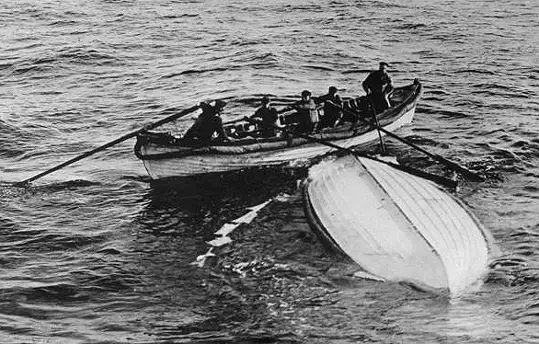
Collapsible Boat B, found adrift by the ship Mackay-Bennett during its mission to recover bodies. (Click image to enlarge)